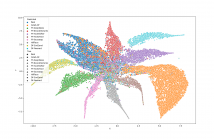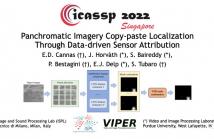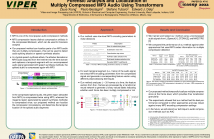
- Read more about ADVERSARIAL EXAMPLE DETECTION BAYESIAN GAME
- Log in to post comments
Despite the increasing attack ability and transferability of adversarial examples (AE), their security, i.e., how unlikely they can be detected, has been ignored more or less. Without the ability to circumvent popular detectors, the chance that an AE successfully fools a deep neural network is slim. This paper gives a game theory analysis of the interplay between an AE attacker and an AE detection investigator. Taking the perspective of a third party, we introduce a game theory model to evaluate the ultimate performance when both the attacker and the investigator are aware of each other.
- Categories:
 18 Views
18 Views
- Read more about EXPLOITING PRNU AND LINEAR PATTERNS IN FORENSIC CAMERA ATTRIBUTION UNDER COMPLEX LENS DISTORTION CORRECTION
- Log in to post comments
More complex and ever more common lens distortion correction post-processing is seriously hampering state-of-the-art camera attribution techniques. In this paper, we show that
- Categories:
 15 Views
15 Views
- Read more about ASSD: Synthetic Speech Detection in the AAC Compressed Domain
- Log in to post comments
Synthetic human speech signals have become very easy to generate given modern text-to-speech methods. When these signals are shared on social media they are often compressed using the Advanced Audio Coding (AAC) standard. Our goal is to study if a small set of coding metadata contained in the AAC compressed bit stream is sufficient to detect synthetic speech. This would avoid decompressing of the speech signals before analysis. We call our proposed method AAC Synthetic Speech Detection (ASSD).
- Categories:
 27 Views
27 Views
- Read more about DEEPFAKE SPEECH DETECTION THROUGH EMOTION RECOGNITION: A SEMANTIC APPROACH
- Log in to post comments
In recent years, audio and video deepfake technology has advanced relentlessly, severely impacting people's reputation and reliability.
Several factors have facilitated the growing deepfake threat.
On the one hand, the hyper-connected society of social and mass media enables the spread of multimedia content worldwide in real-time, facilitating the dissemination of counterfeit material.
- Categories:
 22 Views
22 Views
- Read more about Custom attribution loss for improving generalization and interpretability of deepfake detection
- Log in to post comments
The simplicity and accessibility of tools for generating deepfakes pose a significant technical challenge for their detection and filtering. Many of the recently proposed methods for deeptake detection focus on a `blackbox' approach and therefore suffer from the lack of any additional information about the nature of fake videos beyond the fake or not fake labels. In this paper, we approach deepfake detection by solving the related problem of attribution, where the goal is to distinguish each separate type of a deepfake attack.
- Categories:
 8 Views
8 Views
- Read more about A ROBUST DEEP AUDIO SPLICING DETECTION METHOD VIA SINGULARITY DETECTION FEATURE
- Log in to post comments
There are many methods for detecting forged audio produced by conversion and synthesis. However, as a simpler method of forgery, splicing has not attracted widespread attention.
Based on the characteristic that the tampering operation will cause singularities at high-frequency components, we propose a high-frequency singularity detection feature obtained
- Categories:
 18 Views
18 Views
- Read more about A ROBUST DEEP AUDIO SPLICING DETECTION METHOD VIA SINGULARITY DETECTION FEATURE
- Log in to post comments
There are many methods for detecting forged audio produced by conversion and synthesis. However, as a simpler method of forgery, splicing has not attracted widespread attention.
Based on the characteristic that the tampering operation will cause singularities at high-frequency components, we propose a high-frequency singularity detection feature obtained
- Categories:
 18 Views
18 Views
- Read more about Panchromatic imagery copy-paste localization through data-driven sensor attribution
- Log in to post comments
Overhead images can be obtained using different acquisition and processing techniques, and they are becoming more and more popular. As with common photographs, they can be forged and manipulated by malicious users. However, not all image forensics methods tailored to normal photos can be successfully applied out of the box to overhead images. In this paper we consider the problem of localizing copy-paste forgeries on panchromatic images acquired with different satellites.
- Categories:
 24 Views
24 Views
- Read more about ADT: ANTI-DEEPFAKE TRANSFORMER
- Log in to post comments
Recently almost all the mainstream deepfake detection methods use Convolutional Neural Networks (CNN) as their backbone. However, due to the overreliance on local texture information, which is usually determined by forgery methods of training data, these CNN based methods cannot generalize well to unseen data. To get out of the predicament of prior methods, in this paper, we propose a novel transformer-based framework to model both global and local information and analyze anomalies of face images.
- Categories:
 16 Views
16 Views
- Read more about FORENSIC ANALYSIS AND LOCALIZATION OF MULTIPLY COMPRESSED MP3 AUDIO USING TRANSFORMERS
- Log in to post comments
Audio signals are often stored and transmitted in compressed formats. Among the many available audio compression schemes, MPEG-1 Audio Layer III (MP3) is very popular and widely used. Since MP3 is lossy it leaves characteristic traces in the compressed audio which can be used forensically to expose the past history of an audio file. In this paper, we consider the scenario of audio signal manipulation done by temporal splicing of compressed and uncompressed audio signals. We propose a method to find the temporal location of the splices based on transformer networks.
icassp_2022_poster.pdf
- Categories:
 14 Views
14 Views